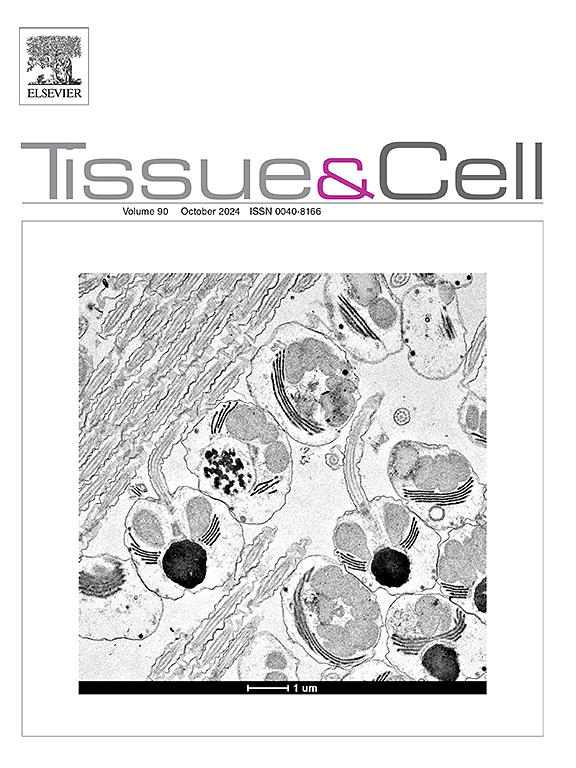Impact of fluoride exposure at different concentrations on preosteoblastic cells: Molecular, biochemical, and morphological insights
IF 2.7
4区 生物学
Q1 ANATOMY & MORPHOLOGY
引用次数: 0
Abstract
Fluoride can harm various tissues depending on its concentration and exposure duration. While its effects on mineralized tissues like bones and teeth are known, few studies have explored its impact on preosteoblastic cells. This study examined the effects of fluoride on differentiating osteoblastic cells. M3CT3-E1 preosteoblastic cells were cultured for 24 h or 3, 5, or 7 days with fluoride concentrations of 1, 10, or 100 μg/mL. Cell viability, oxidative stress biomarkers, mitochondrial membrane potential, cell cycle distribution, apoptosis, and morphology were assessed. After statistical analysis, At 100 μg/mL, fluoride modulated cell viability in a dose- and time-dependent manner, increasing reactive oxygen species levels and lipid peroxidation (1.382 ± 0.163 vs. 0.826 ± 0.081; p = 0.0125). Oxidative stress markers such as superoxide dismutase (SOD) (4.008 ± 0.425 vs. 0.724 ± 0.474; p = 0.0025) and glutathione (GSH) (78.38 ± 4.506 vs. 45.65 ± 2.900; p = 0.0003) were also elevated. High fluoride concentrations impaired mitochondrial activity and disrupted the cell cycle, affecting the G0/G1, S, and G2/M phases. These changes caused irreversible damage, including apoptosis and alterations in cell morphology. High fluoride concentrations can significantly damage preosteoblastic cells, reducing viability, altering redox status, impairing mitochondrial function, and disrupting the cell cycle, leading to cell death. These findings underscore that fluoride toxicity is concentration-dependent and reinforce the safety of exposure to doses of fluoride such as those found in the optimally fluoridated water.
不同浓度氟化物暴露对成骨前细胞的影响:分子、生化和形态学的见解
氟化物对各种组织的危害取决于其浓度和暴露时间。虽然它对骨骼和牙齿等矿化组织的影响是已知的,但很少有研究探讨它对成骨前细胞的影响。本研究考察了氟化物对成骨细胞分化的影响。M3CT3-E1成骨前细胞培养24 h或3、5、7天,氟浓度分别为1、10、100 μg/mL。评估细胞活力、氧化应激生物标志物、线粒体膜电位、细胞周期分布、凋亡和形态学。经统计分析,在100 μg/mL时,氟化物以剂量和时间依赖性方式调节细胞活力,增加活性氧水平和脂质过氧化(1.382 ± 0.163 vs. 0.826 ± 0.081; = 0.0125页)。氧化应激标志物如超氧化物歧化酶(SOD)(4.008 ± 0.425 vs. 0.724 ± 0.474;p = 0.0025)和谷胱甘肽(GSH)(78.38 ± 4.506 vs. 45.65 ± 2.900;P = 0.0003)也升高。高浓度氟损害线粒体活性,扰乱细胞周期,影响G0/G1、S和G2/M期。这些变化引起不可逆的损伤,包括细胞凋亡和细胞形态的改变。高浓度氟化物可显著损害成骨前细胞,降低活力,改变氧化还原状态,损害线粒体功能,破坏细胞周期,导致细胞死亡。这些研究结果强调,氟化物毒性是浓度依赖性的,并加强了接触剂量氟化物的安全性,例如在最佳加氟水中发现的氟化物。
本文章由计算机程序翻译,如有差异,请以英文原文为准。
求助全文
约1分钟内获得全文
求助全文
来源期刊

Tissue & cell
医学-解剖学与形态学
CiteScore
3.90
自引率
0.00%
发文量
234
期刊介绍:
Tissue and Cell is devoted to original research on the organization of cells, subcellular and extracellular components at all levels, including the grouping and interrelations of cells in tissues and organs. The journal encourages submission of ultrastructural studies that provide novel insights into structure, function and physiology of cells and tissues, in health and disease. Bioengineering and stem cells studies focused on the description of morphological and/or histological data are also welcomed.
Studies investigating the effect of compounds and/or substances on structure of cells and tissues are generally outside the scope of this journal. For consideration, studies should contain a clear rationale on the use of (a) given substance(s), have a compelling morphological and structural focus and present novel incremental findings from previous literature.
 求助内容:
求助内容: 应助结果提醒方式:
应助结果提醒方式:


